Posted by Elena del Valle on March 1, 2013
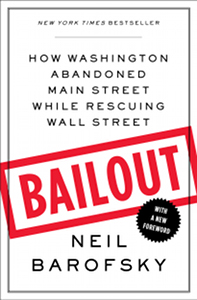
Bailout book cover
Photos: Free Press
Neil Barofsky was assistant U.S. Attorney for the Southern District of New York when he was called to serve his country. From December 2008 to March 2011 he was special inspector general in charge of oversight of the Troubled Asset Relief Program (TARP) under the Bush and Obama administrations. It was his job to oversee the program against fraud and abuse in the spending of $700 billion allocated to the national bank rescue.
In Bailout How Washington Abandoned Main Street While Rescuing Wall Street (Free Press, $16), a bestseller he spent 27 months living and four months writing, he describes his experience and explains why he became disillusioned with the system and the mishandling of billions in public money by representatives of both political parties. The paperback edition was published last month with a new Foreword in which he outlines a number of banking scandals that have come to light following the original publication of the book. He mentions the London InterBank Offered Rate (LIBOR), the accusations that HSBC was involved in transactions with terrorist and narcotics, the accusations that Wells Fargo and Bank of America defrauded the government, and scandals in which JPMorgan Chase, Deutsche Bank, and Credit Suisse were named.
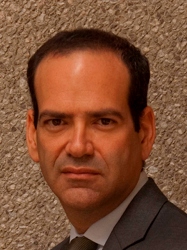
Neil Barofsky, author, Bailout
The 272-page book is divided into twelve chapters: Fraud 101; Hank Wants to Make It Work; The Lapdog, the Watchdog and the Junkyard Dog; I Won’t Lie for You; Drinking the Wall Street Kool-Aid; The Worst Thing That Happens, We Go Back; By Wall Street for Wall Street; Foaming the Runway; the Audacity of Math; The Essential $7,700 Kitchen Assistant; Treasury’s Backseat Driver; and Happy Endings.
In the book, Barofsky discusses the debacle that resulted in only $1.4 billion out of $50 billion in bailout money designated to rescue homeowners reaching intended people; how the interests of powerful people and companies ultimately won repeatedly over the interests of taxpayers; the fraud, obstruction, deceit and immoral spending of public monies to favor Washington and Wall Street parties; the government’s unwillingness to reign in the offenders and hold them accountable; and the criminal justice system’s inability to address the problems that plague the system.
The author, now senior fellow at New York University School of Law, explains in the Afterword that his anger at the injustices in the system drove him to write the book. He goes on to say that Americans should lose faith in their government, deplore the politicians and regulators that allowed taxpayer dollars to go to the banks with no accounting for how they were spent, and be revolted by a financial system that rewards failure and protects the fortunes of the wrongdoers. He hopes that the rage of Americans drives reform and rips the system away from the “corrupting grasp of the megabanks.”
Comments:
Filed Under: Books
Posted by Elena del Valle on February 22, 2013

Can’t Buy Me Like book cover
Photos: Youplusme, Michael Albans
An ad critic and agency founder believe we are in the Relationship Era, a time when consumers have a voice that is especially loud on social media channels and when advertising alone isn’t enough. Some of the best performing companies in this era, they believe, strive to communicate in an authentic and transparent way that generates trust and superior results, according to Doug Levy, founder and chief executive officer, Meplusyou, and Bob Garfield, co-host, NPR’s On the Media.
In their book, Can’t Buy Me Like: How Authentic Customer Connections Drive Superior Results (Portfolio, $25.95), a 229-page hardcover book published this year, they outline their thoughts about the Relationship Era illustrating their opinions with case studies of well known brands such as Patagonia, Panera, Citibank, McDonald’s, Progressive Insurance and United Airlines.
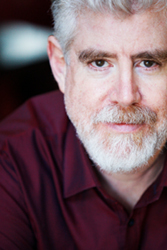
Bob Garfield, co-author Can’t Buy Me Like
Garfield explained by email that the book was written for anyone in an institution that has attempted to manage or manipulate perceptions of its organization through advertising or public relations. The book project took about 18 months from beginning to publication in addition to the years of experience associated with the topic, he said.
The authors are convinced four main factors have led the way to the Relationship Era: the fragmentation and collapse of mass, the increase of transparency, the rise of social connectivity and trust relationships with peers. In their opinion, these changes have resulted in power shifts that have removed absolute control of a brand’s image and reputation from the brand and the public’s ability to share positive and negative information in social media forums.
Instead of listening to customers in order to find a way to manipulate them into buying their product or service, marketers need to change their approach, the authors say. Everyone wants to be liked but being liked genuinely is different from being bribed or browbeat into liking someone as some people attempt to do, they point out.
Brands with authenticity will win over customers while brands that try to pull a fast one will be found out, according to the authors. They go on to point out that relationships based on trust require effort and time; that they are the result of cultivation rather than persuasion.
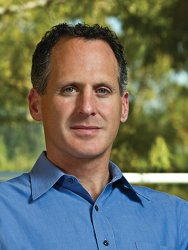
Doug Levy, co-author Can’t Buy Me Like
Levy explained by phone that a site with purchased likes has diminished credibility. He went on to say that an example of likes that are hard to fake are those from friends in social media. It’s his opinion that companies that care for something other than just making money and that develop relationships based on trust stand out and find success. Examples of companies that care about something beyond profit, even though they are imperfect, include Apple, Southwest Airlines, and Whole Foods Market. He’s concerned that people who see how powerful relationships based on care and trust are will attempt to fake it. People can tell when a company’s behavior and its message don’t match, the author said.
The book is divided into eleven chapters: Good-bye to All That; The Relationship Era; Trust Me; On Purpose; Sustain; The Secret Secret; That Thing Called Like; The Shift; Does and Don’ts and No, Really, Don’ts; Bank and Trust; and This Could be the End of a Previously Very Good Relationship.
Comments:
Filed Under: Books
Posted by Elena del Valle on February 15, 2013
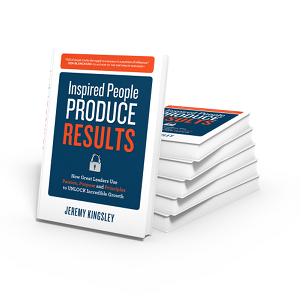
Inspired People Produce Results
Photos: Jeremy Kingsley
In his recently published book, Inspired People Produce Results: how great leaders use passion, purpose, and principles to unlock incredible growth (McGraw-Hill, $24.95), Jeremy Kingsley, who makes a living as a speaker, explains why he believes leaders share common characteristics that drive employees to success.
He calls workers born between 1965 and 1994 Generation Me and points out that while “They are smart, optimistic, creative, and flexible, and thrive on diversity” they also are described as having a sense of entitlement, being opinionated, having a free-spending style, and insisting on knowing why they are to do something when assigned a task.
While employees follow the instructions of a manager they do more when they follow a leader so those who want to go to the next level and find success should strive to lead, he says. According to him perhaps the most important attribute of a manager or leader is his or her ability to inspire others.
To succeed at the front of the line in the twenty-first century leaders should, he says in the book, have passion, purpose, loyalty, strive to establish a positive working environment, give personal attention to each person in their team, be understanding, and have patience, good communication skills, and integrity.
The 192-page book is divided into ten chapters: What Do Leaders Do? Inspire; What Inspires People? Passion; What Inspires People? Purpose; What Inspires People? Loyalty; What Inspires People? Caring, Part I; What Inspires People? Caring, Part II; What Inspires People? Understanding; What Inspires People? Patience; What Inspires People? Communication; and What Inspires People? Integrity.
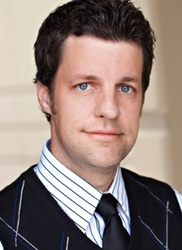
Jeremy Kingsley, author, Inspired People Produce Results
Kingsley, president of OneLife Leadership, has spoken to over 500,000 people at live events around the world, according to his biography. The author of four books lives in Columbia, South Carolina with his wife and two sons.
Comments:
Filed Under: Books
Posted by Elena del Valle on February 8, 2013
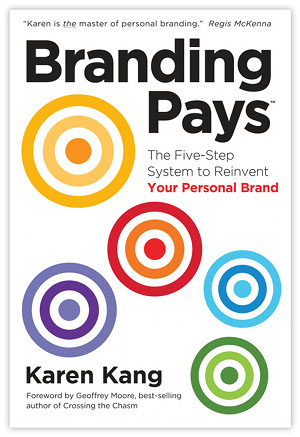 Branding Pays
Branding Pays
Photos: BrandingPays LLC
Karen Kang, founder of a personal branding company, believes a person’s brand is possibly his or her most important asset and that today’s global reach makes personal branding essential. According to her, where competition used to be local in the past, today competitors can be found across international boundaries and making an impression is more important than ever. In BrandingPays: The Five-Step System to Reinvent Your Personal Brand (BrandingPays LLC, $24.95), a 207-page hardcover book published this year, she defines a personal brand as a person’s image and reputation and explains her reasons for prioritizing branding.
Adapting to a changing environment, understanding who you are and the value you bring are basic steps in reinventing your personal brand, she says in the book. She wrote the book for professionals seeking new employment opportunities, recent graduates looking for their first job, and entrepreneurs needing to develop personal and company identities.
The book is divided into a short Introduction, a Conclusion and eight chapters: Take Charge of Your Personal Brand; Positioning; Messaging; Brand Strategy, Ecosystem; Action Plan; 360-Degree Branding: Vision, Symbols, Words and Deeds; and Portable Branding and Social Media: Getting Started. In the book, Kang uses case studies to illustrate her points. In the Conclusion, she points to results from one of her personal branding seminars at a Fortune 100 company where all the participants in the program for women executives accomplished their goals of promotion or a different job within one year of the seminar.
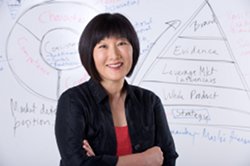
Karen Kang, author, Branding Pays
Kang, a brand strategist with twenty years of experience, is chief executive officer of BrandingPays LLC. A former partner with Regis McKenna Inc. she has trained thousands of professionals on the BrandingPays System for personal branding, and has consulted for 150 organizations, according to her biography. She is a former journalist turned advertising and public relations practitioner.
Comments:
Filed Under: Books
Posted by Elena del Valle on February 1, 2013
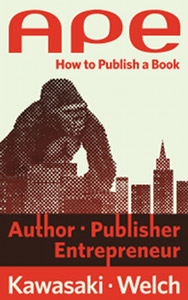
APE How to Publish a Book
Photos: Guy Kawasaki, Shawn Welch
It has become increasingly popular for leaders, business executives and owners and news makers to author non fiction books in which they espouse their ideas on an area of expertise. At the same time, the availability of e-readers and digital books has expanded the reach of potential readers, made books more affordable and reduced the need for intermediaries. Fast changing digital book technology has made publishing ever easier and accessible.
Digital books have a long shelf life, lend themselves to revisions more readily and easily than print books, pay (if they sell) authors better, expand distribution beyond domestic borders, and allow authors and readers direct contact. However, understanding the fragmented, and at times confusing, book publishing industry can be trying.
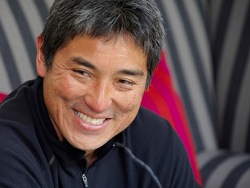
Guy Kawasaki
In 2011, the publisher of Guy Kawasaki’s The New York Times bestseller, Enchantment, could not fill an order for 500 ebook copies of the title. The experience, led Kawasaki to self-publish his next book, What the Plus! As a result, he learned first-hand many of the issues related to today’s self-publishing process. He then collaborated with Shawn Welch, an app developer and author, to write and publish APE: Author, Publisher, Entrepreneur How to Publish a Book, a 324-page book, available in printed and e-book formats, published in late 2012.
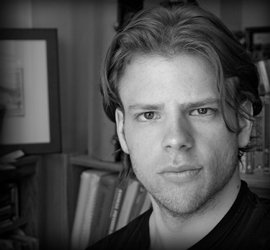
Shawn Welch
Each chapter features a quote at the beginning and a short summary at the end. The authors begin by addressing the reasons for writing a book, advising would be writers that writing can be a “lonely and difficult process” and inviting them to reflect on the reasons they want to write. The changes in the publishing industry that make self publishing accessible to a broader group of writers than ever before don’t guarantee better books just a more accessible system, they explain later on.
They call the process of self publishing artisanal publishing and describe three main aspects required for success, authoring, publishing and promoting the title. The book itself is divided into sections to address the three areas. Kawasaki and Welch believe that type of publishing, in contrast to traditional print publishing, allows authors to control every aspect of the process, freeing them from the ties that used to bind them to large, traditional publishers.
Kawasaki is the author of nine other books in addition to the three mentioned above. He is the co-founder of Alltop.com website. Previously, he was the chief evangelist of Apple. Welch is the author of From Idea to App, iOS 5 Core Frameworks, and iOS 6 for Developers as well as the developer of several iOS apps. Previously he worked as a senior media-editor for Pearson Education.
Comments:
Filed Under: Books
Posted by Elena del Valle on January 25, 2013
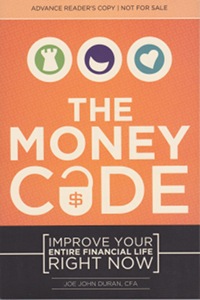
The Money Code
After finding what he thought was “the pinnacle of the American dream” Joe John Duran, a financial planner originally from Rhodesia (now Zimbabwe), realized that instead of finding freedom from money he was becoming enslaved by it. This caused him to seek change and evolved thinking. He believes decisions about money are usually emotional and affected by people’s personal histories and way of looking at things which in turn affect how they make decisions and the quality of those decisions. To obtain financial success it is necessary, according to him, to separate emotional and logical motivation.
In The Money Code: Improve Your Entire Financial Life Right Now (Greenleaf Book Group Press, $14.95) he outlines the path, he believes, leads to lasting financial solutions; a way to pass from what people say they want to what they are doing to get there. He sets out to help readers discover their attitudes toward money and identify a “road map for making sound financial decisions.” He proposes that money serves three main purposes: avoidance of pain by protecting what a person values in the future, feeling good by facilitating access to things that make a person happy, and providing the means to help others.
In the 155-page softcover book, he presents his five Money Secrets: tough choices are part of life, how someone makes decisions determines his entire life, a person’s biases affect every decision he or she makes, inconsequential distractions come along, and a good process is required to make good decisions. He relies on hypothetical situations, a fictional character and check-lists to illustrate his points in eleven chapters.
Duran, founding partner of United Capital, a wealth counseling firm, previously served as president of GE Private Asset Management. He holds the Chartered Financial Analyst (CFA) designation and earned MBA degrees from Columbia University and UC Berkeley. The the author of two other books, he lives in Laguna Beach, California, with his wife and daughters.
Comments:
Filed Under: Books
Posted by Elena del Valle on January 18, 2013
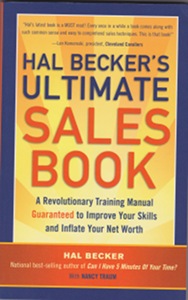
Hal Becker’s Ultimate Sales Book
Hal Becker, once the top salesman out of a salesforce of 11,000 at Xerox, and now a consultant, with Nancy Traum, president and chief executive officer, Solon Chamber of Commerce, published Hal Becker’s Ultimate Sales Book (CareerPress, $15.99) last year. In the 254-page softcover book written to be a “sales book and a sales training course rolled into one,” they outline ideas to assist readers in improving their sales skills.
Chapters address: What Great Salespeople Know; The Importance of Listening; Preparing for the Sales Call; The Importance of Questions; Increasing Your Sales; Cold Calls, Phone Selling and Other Contact Options; Time Management; Handling Objections; Closing the Sale; Customer Care; Role-Playing; and You’ve Earned a Bonus. The chapters feature lessons and quizzes.
In his opinion, a good sales person prepares to start selling once he or she meets with their customer while a great salesperson prepares for the sale in advance of the meeting. Preparing for a sale or negotiation is important, he stresses in Lesson 10. “The more prepared you are, the better your chance for success,” he says. In that lesson he suggests reviewing goals, making sure to have notes ready, paying attention to a prospective client’s office, being real and leaving cell phones and electronic devices behind to avoid being distracted during the meeting.
According to promotional materials, Becker conducts seminars or consults for 140 organizations a year, including IBM, Disney, United Airlines, and AT&T. He is the author of Can I have 5 Minutes Of Your Time?, Lip Service, and Get What You Want.
Comments:
Filed Under: Books
Posted by Elena del Valle on January 11, 2013

Entering the Shift Age
Photo: Sourcebooks
In his most recent book David Houle, a self described futurist, examines the historic transformation of humans. He explains that our society has been transformed by a series of eras each with its own characteristics. First, the Agricultural Age brought about organized cultivation and permanent settlements in lieu of the nomadic lifestyle humans had had for thousands of years. He discusses how the Industrial Revolution led to yet other dramatic changes in the world; and most recently the Information Age transformed work and personal environments in the United States and later internationally with record speed. He is convinced that now we are in a new era which is having a dramatic impact on society.
Houle, author, Entering the Shift Age The End of the Information Age and the New Era of Transformation (Sourcebooks, $8.69), a soon to be published e-book of 3,431 tablet length pages, believes we left the Information Age behind in 2006 following the Threshold Decades and transitioned quietly to what he calls the Shift Age which is still being created and defined by three dominant forces: the Flow to Global, the Flow to Individual and Accelerating Electronic Connectedness.
People will arrive at a point where they will consider that they are part of a global community, rather than an international one, he points out in Chapter Three. This is due in part because the speed of communications has shrunk the world, opened borders driving world politics inward and increasing multicultural integration, he explains in the book.
Houle is convinced that during the Shift Age a greater number of people will migrate than during previous ages in part because there are more people and in part because a higher percent of the population will migrate. At the same time, due to the global economy, he says in Chapter Twenty-Seven, “increasingly we will look globally for employment or contract work.” In the future, people will work together in project and then separate.
Millenials he has met have a strong desire to experience the world, planning to spend up to ten years working at various places around the globe. Digital Natives are ever more interconnected into the global community, he says. They are the group with least place-base identity. Africa is poised to enter a golden age in 2020 and such a boom will impact mass migration, he says toward the end of the book.
While the book was legible in a tablet the formatting was riddled with odd line breaks, some words with a random mix of lowercase and uppercase letters that did not follow a standard publishing style, and hard to read figures due to the odd formatting display on the tablet screen.
Houle, a strategist and keynote speaker, won a Speaker of the Year award from Vistage International. According to his biography, he has spoken to or advised more than two thousand chief executive officers and business owners in the past four years.
Comments:
Filed Under: Books
Posted by Elena del Valle on December 14, 2012
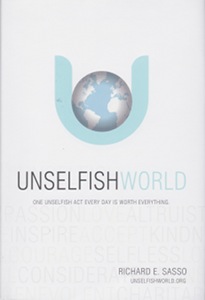
Unselfish World book cover
For ten years Richard Sasso, chief executive officer, MSC Cruises of Fort Lauderdale, Florida had an idea he wanted to develop. He wanted to encourage others to pay attention to their surroundings. Doing so would help them realize all people share a common bond and lead them to be giving, he thought. Last year he brought his idea to a wide audience with the publication of UnselfishWorld (self published, $27) and the establishment of a non profit foundation and related website.
Sasso believes that although the human instinct is to be selfish it is possible to counter our instinct in order to be unselfish. Becoming unselfish, he says in the Forward of the book, can make a difference in the world “to the protection of our homes, our families, and even reach for the possibility of world peace.”
The 83-page hardcover book is divided into 15 chapters where he addresses the main questions of Why, Who, What, When, Where, How and goes on to explain his overall concept. He believes when we do kind things we should not do them seeking a reward but says that “life has some interesting was to reward us, even when we least expect it.”
The mission of Unselfish World, listed as a non profit organization with a Miami address on the website, is “to create an environment for you to become the most unselfish person you can be. Once you change your own behavior, you can also help others do the same.”
Visitors to the website are invited to sign up, share unselfish acts, contribute (two corporate sponsors are listed) to benefit three organizations, purchase the book and related stickers. Sasso, a cruise industry veteran with 40 years of experience including founding and leading cruise lines, believes his life has been nearly perfect. According to the book’s bio, his priorities are his family and friends and his passion to see his new project succeed.
Comments:
Filed Under: Books
Posted by Elena del Valle on December 7, 2012

Looking for Esperanza book cover
Photos: Benu Press
While watching the news the attention of Adriana Paramo, an author and anthropologist, was drawn to a story about an immigrant mother who had carried her dead daughter’s body with her through a tough desert journey from Mexico with her family. Perhaps because she is an immigrant herself or because the plight of others touches her the woman’s case drew Paramo. She spent 18 months searching for Esperanza, the woman in the news, immersing herself in the world of undocumented workers in the small town where she thought Esperanza might live.
Across Florida, in vegetable fields, citrus groves, ferneries, and packing houses, she encountered “an underground subculture of hungry undocumented women, a hidden world of wage slaves, a microcosm of false names, false Social Security numbers, and false hopes.” During that time, she met many people and heard about many unfortunate women and their sorrow filled stories.
She stopped writing following the death of her mother due to her extended bereavement. Eight years after she began her search for Esperanza Looking for Esperanza: The Story of a Mother, a Child Lost, and Why They Matter to Us (Benu Press, $24.95), a 142-page softcover book about her experience, was published. The book chronicles the plight of undocumented women living in Florida who took great risks hoping for a better life for those they love.

Adriana Paramo, author, Looking for Esperanza
“Although I write almost exclusively about women, I hope my readership is comprised by both men and women. Anyone with a beating heart, anyone with a shred of humanity in them, anyone with hope for a world where justice and equality rule our immigration policies and our relationship with food, is a good target for my book,” said Paramo in response to a question about the target audience for her book.
She believes the book “has brought awareness to the appalling living and working conditions of our undocumented farmworkers” and has also “created a sort or urgency, a need for the reader to say ‘what can we do?’ or ‘how can we change this?’” Two college professors plan to use the book in their classroom.
“My biggest challenge was to accept my limitations as an anthropologist. As a social scientist all I could do was to observe, document and report. With each story told to me, I wanted to do something tangible and immediate; I wanted to have the power to find them better housing, better food, to give them access to the same resources I have access to. It was very hard to realize and accept my own helplessness,” said Paramo when asked about challenges and rewards of writing the book. “To have the book published. Holding the book in my hands makes me feel that I have done something relevant, that Paulina, Laura, Griselda, Rosa, Cristina and Esperanza are no longer faceless, voiceless wetbacks, but women like me.”
Paramo, a non fiction writer born and raised in Colombia, won the 2011 Benu Press Award for Social Justice for this book. She is a resident of Florida.

Click to buy Looking for Esperanza
Comments:
Filed Under: Books







 Branding Pays
Branding Pays



















